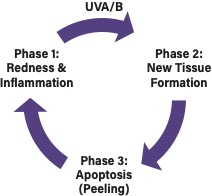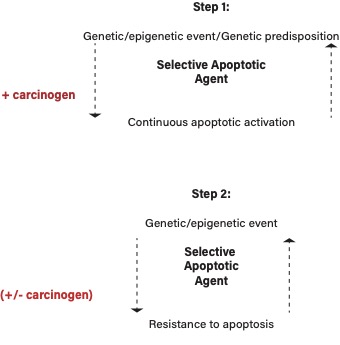Chanda Siddoo-Atwal, President and Primary Biochemist of Moondust Cosmetics Ltd. continues her discussion on sunburn & skin cancer science
Looking at the role of resveratrol & phytochemicals in skin cancer chemoprevention/therapy (an excerpt from a chapter in “Comprehensive Clinical Oncology”, 2nd/3rd editions), Siddoo-Atwal comments further on sunburn & skin cancer science.
Resveratrol belongs to a class of phytochemical compounds known as polyphenols. Specifically, it is a phytoalexin that is found in many edible plants including grape skins, hops, peanuts, pines, and numerous berries (blackberries, black currants, blueberries, mulberries, and cranberries) [1].
Although natural products have been used to treat chronic diseases including cancer since ancient times, there is current interest in the use of natural compounds as chemopreventive and therapeutic agents for human populations since there are many unpleasant side-effects associated with cancer chemotherapy and radiation therapy.
In addition to resveratrol, some other prime phytochemical candidates include procyanidins derived from grape seeds, which induce apoptosis (programmed cell death) in human prostate carcinoma cells. A polyphenol derived from green tea, particularly, epigallocatchin-3-gallate (EGCG), applied topically or taken orally in tea displays an inhibitory effect on skin carcinogenesis via the selective stimulation of apoptotic activity in UV-induced mouse skin tumours and precancerous lesions, respectively. Lastly, Chinese bee propolis, has anti-proliferative activity in colon cancer cells [2].

Preneoplastic lesions in sunburn & skin cancer
The first successful pre-clinical study with resveratrol was reported in a two-stage mouse carcinogenesis model utilising 7,12 – dimethylbenza[a]anthracene [DMBA] as the initiator and 12-O-tetradecanoyl-13-acetate [TPA] as the promoter. Resveratrol inhibited tumorigenesis in this mouse skin cancer model and it also prevented the development of preneoplastic lesions in carcinogen-treated mouse mammary glands in cell culture.
Other similar studies followed confirming that topical resveratrol treatment reduced tumour incidence, multiplicity, and volume while delaying the onset of tumorigenesis. One of the most notable set of studies was conducted in SKH-1 hairless mice, which are susceptible to ultraviolet radiation-induced skin cancer via a similar mechanism to those specific humans who experience apoptotic sunburn or “scientific sunburn”.
Ultraviolet radiation (UV) is a complete carcinogen in this particular mouse model and DNA damage such as double-strand breaks caused by the radiation directly stimulates cell death. It is the repeated activation of these apoptotic mechanisms in skin cells by ultraviolet rays that appears to be directly linked to tumour formation in this model. It has been demonstrated that resveratrol protects against UVB exposure-mediated skin carcinogenesis in SKH-1 hairless mice by selectively inducing apoptosis in premalignant and malignant cells.
Naturally, it cannot always be assumed that test results obtained in animals will hold true in humans due to significant differences in some biochemical pathways. Resveratrol has already been shown to display selective apoptotic properties inducing programmed cell death in pre-cancer and cancer cells in a mouse skin carcinogenesis model. Similarly, a comparable cancer model in humans involving susceptibility to apoptotic sunburn [Diagram 1] can result in abnormal growth or “tumour” formation and/or skin cancer without proper sunscreen protection, as previously described.

Resveratrol ointment and its benefits
In a case-study, following daily topical application of a resveratrol ointment {50 mg/ml} in an aloe base, considerable regression of a growth induced by UVA/UVB radiation was observed within 10 days. Moreover, with the diligent application of a zinc oxide sunscreen formulation previously reported to block UV-induced apoptosis, there was complete remission and there has been no recurrence of the lesion since.
These results taken together with laboratory studies on animals are suggestive that tumour formation requires at least two discrete events to take place in response to a carcinogen. The first involves an elevation of apoptosis in a particular tissue due to a genetic predisposition, stress, or mutation.
The second confers resistance to apoptosis in that same tissue resulting in the formation of an abnormal growth due to a dysregulation of cell number homeostasis. In addition, this case-study suggests that both these events can be reversible when treated with a selective apoptotic agent like resveratrol and, hence, they may be either genetic or epigenetic in nature [Diagram 2].
References
- Siddoo-Atwal C. (2021) Chapter 57 – A Potential Role for Resveratrol in Cancer Chemporevention and Therapy in “Comprehensive Clinical Oncology: Current Practices” second edition, Libromed Panama (edited by Restrepo CJ, MD).
- Siddoo-Atwal C. (2022) Chapter 57 – A Potential Role for Resveratrol and Other Phytochemicals in Cancer Chemoprevention and Therapy in “Comprehensive Clinical Oncology: Current Practices” third edition, Libromed Panama (edited by Restrepo CJ, MD)
- Siddoo-Atwal C (2019) Chapter 4 – Genes That Can Cause Cancer in “Gene Expression Profiling in Cancer” INTECH (edited by Vlachakis D). DOI: 10.5772/intechopen.83549
- Siddoo-Atwal C (2017) A New Approach to Cancer Risk Assessment: An Overview, LAP Lambert Academic Publishing
*Please note: This is a commercial profile
© 2019. This work is licensed under CC-BY-NC-ND.











